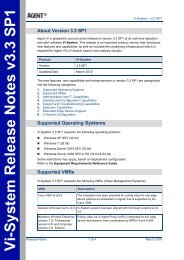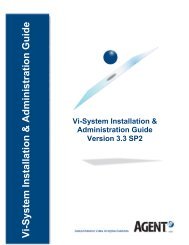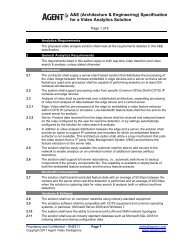Situational awarenes - Agent Vi
Situational awarenes - Agent Vi
Situational awarenes - Agent Vi
Create successful ePaper yourself
Turn your PDF publications into a flip-book with our unique Google optimized e-Paper software.
Product<br />
Exploration<br />
VCA Levels UP<br />
<strong>Vi</strong>deo content analysis is available on<br />
edge-based and server-based devices.<br />
Edge-based VCA is capable of utilizing<br />
the bandwidth, as video images are<br />
processed on the camera itself. Serverbased<br />
VCA allows for more advanced<br />
calculations since it has a larger<br />
processor. Though all VCA are prone<br />
to false alarms, advances in algorithms<br />
and use of high resolution cameras will<br />
continue to reduce those rates. Before<br />
deploying VCA in any environment,<br />
users must fully understand their<br />
environments to see if it is suitable or if<br />
it will actually assist in their operations.<br />
Smart <strong>Vi</strong>deo<br />
<strong>Situational</strong><br />
<strong>Vi</strong>deo content analysis assists users when monitoring different<br />
environments. This feature highlights the pros and cons of<br />
intelligence in the front and back end.<br />
• By Christine Chien<br />
P.42<br />
P.50<br />
P.54<br />
Smart <strong>Vi</strong>deo Ensures<br />
<strong>Situational</strong> Awareness<br />
Future Intelligence Aims to<br />
Decrease False Alarms<br />
Food for Thought: Tips to<br />
Accurate VCA<br />
4222 JUL 2013<br />
www.asmag.com 22
Ensures<br />
Awareness<br />
Two years ago, Object<strong>Vi</strong>deo waged<br />
a series of legal battles with<br />
some of the most prominent<br />
names in video surveillance, for the<br />
infringement of intellectual property<br />
relating to video analytics; among the<br />
defendants were Bosch, Sony, Samsung,<br />
and Pelco to name a few. These lawsuits<br />
shook the security industry and gave<br />
rise to an influx of video surveillance<br />
companies who quickly entered into<br />
patent licensing agreements with<br />
Object<strong>Vi</strong>deo, in fear of becoming its next<br />
target. According to previous reports,<br />
Raul Fernandez, CEO of Object<strong>Vi</strong>deo<br />
had not expected the lawsuits to<br />
halt the developments of video<br />
analytics or to suppress the adoption<br />
of the technology. Ironically, no major<br />
breakthroughs in the technology have<br />
emerged since the whole fiasco. Now,<br />
video content analysis (VCA) seems to<br />
be stuck in a peculiar situation where<br />
the technology is maturing, but with<br />
nothing out of the ordinary coming<br />
from it. However, its more advanced<br />
features are now able to reduce the rates<br />
and incidences of false alarms and are<br />
better managed in different devices. The<br />
industry is becoming more realistic and<br />
“down-to-earth” about the capabilities<br />
of VCA, instead of chasing after and/or<br />
promoting “new and cool” features that<br />
will most likely be unreliable once they<br />
are put to the test.<br />
The limited breakthrough in the<br />
technology however, will not be putting<br />
a stop to its growth. According to<br />
MarketsandMarkets, the video analytics<br />
market is expected to grow from US$180<br />
million in 2011 to $867.8 million by 2017,<br />
22 JUL 2013<br />
www.asmag.com 2243
Product<br />
Exploration<br />
at an estimated CAGR of 30.4% from 2012 to<br />
2017.<br />
Current forms of VCA are available in<br />
front-end (edge-based) or back-end<br />
devices. Pros and cons exist for both the<br />
front and back end, and each have its most<br />
suitable use scenario. According to Mahesh<br />
Saptharishi, President & CTO of <strong>Vi</strong>deo IQ, there<br />
are two primary factors that influence the<br />
performance of any VCA system — the quality<br />
and resolution of the video being analyzed<br />
and the amount of processing available to run<br />
VCA algorithms. Lower resolution video, such<br />
as video with considerable noise and heavily<br />
compressed streams all adversely affect<br />
performance. Sophisticated VCA algorithms<br />
require a substantial amount of processing to<br />
run effectively. More recently, advances in the<br />
science of pattern-based video analysis have<br />
helped dramatically increase performance<br />
while requiring a significantly lower<br />
processing budget.<br />
Front-End dE<strong>Vi</strong>ces<br />
Advantages<br />
The advantages of using front-end devices<br />
are most apparent in two ways — it saves<br />
bandwidth and is cost effective. “If there is a<br />
large number of cameras requiring analytics,<br />
placing analytics on the edge makes sense.<br />
Edge placements keep the costs down<br />
by relieving network traffic burden, actual<br />
costs of the analytics, and costs involved in<br />
server farms,” stated John Sepassi, Account<br />
Executive at Intelli<strong>Vi</strong>sion. The use of front-end<br />
devices works exceptionally well for remote<br />
locations or extended facilities where there<br />
is poor or non-existent bandwidth back to<br />
the monitoring location, “as it eliminates<br />
maintaining a remote server and needs only a<br />
low bandwidth connection to send snapshots<br />
of alarm instances,” said Sadiye Guler, Founder<br />
President of intu<strong>Vi</strong>sion.<br />
“When video analytics are placed inside<br />
a camera, and a high degree of video<br />
processing is used to analyze the raw video<br />
as it comes off the imager, every video<br />
The most common<br />
VCA systems base<br />
their alarms on motion<br />
detection (frame<br />
difference) or pixel<br />
analysis (background<br />
modeling).<br />
Mahesh Saptharishi,<br />
President & CTO, <strong>Vi</strong>deo IQ<br />
frame at full resolution is available for the<br />
video content analysis,” commented John<br />
Romanowich, CEO of SightLogix. The ability to<br />
analyze every video frame makes VCA on the<br />
edge more sensitive to feint objects. “Given<br />
the same algorithm, edge analytics using<br />
the original data works better than serverbased<br />
analytics, which works on compressed<br />
data from an IP camera. This is because video<br />
compression is ‘lossy’ and feint objects such<br />
as a person in dark clothing on a dark night<br />
may just be visible in the original video but<br />
filtered out and lost during transmission<br />
of compressed video to the server,” said<br />
Geoff Thiel, CEO of VCA Technology. Having<br />
the loads divided among multiple devices<br />
relieves network traffic burden as analytics<br />
are performed at the camera level, and only<br />
relevant video is sent back to the recorder for<br />
storage.<br />
Disadvantages<br />
Major disadvantages of using VCA at the<br />
front end include its inability to run analytics<br />
that require high CPU, but also the analytic<br />
configuration that is needed for each device.<br />
“Low processing resources result in lower<br />
performance and less features, management<br />
of VCA on large numbers of cameras becomes<br />
<br />
▲ The video analytics market is expected to grow from US$180 million in 2011 to $867.8 milliion by 2017.<br />
4422 JUL 2013<br />
www.asmag.com 22
Product<br />
Exploration<br />
difficult, maintenance is hard because each<br />
new bug fix or feature requires a firmware<br />
upgrade, and new features may not be<br />
supported by existing cameras because of the<br />
higher processing requirements,” stated Zvika<br />
Ashani, CTO of <strong>Agent</strong> <strong>Vi</strong>deo Intelligence. Users<br />
also have to be sure their VMS is compatible<br />
and supports all the features and functions of<br />
the VCA in their cameras for it to operate at its<br />
full capacity.<br />
Back-End dE<strong>Vi</strong>ces<br />
Advantages<br />
Similar to front-end devices, VCA in the<br />
back end offers a plethora of advantages.<br />
Back-end devices, usually server solutions,<br />
bring all the video data back to a central<br />
location to be managed, analyzed, and<br />
recorded, thereby providing a central location<br />
for backup, redundancy, monitoring, and<br />
network security. Server-based systems<br />
might be better for “highly sensitive sites and<br />
environments with challenging views and<br />
cluttered scenes, illumination changes, and<br />
reflections,” according to Guler, as VCA on<br />
servers makes it easier to run more advanced<br />
and complex analytics that require higher<br />
processing power in real time. Using serverbased<br />
VCA efficiently manages multiple<br />
analytics configurations and allows better<br />
analysis through reports, charts, snapshots,<br />
and recordings. “When the server is upgraded,<br />
the increased performance is immediately<br />
reflected in the analysis without having to<br />
change any cameras. Updating VCA algorithm<br />
software is carried out centrally and is<br />
relatively quick and straightforward,” said Frank<br />
Brandtner, Head of Administrative Product<br />
Management at Geutebruck. Furthermore,<br />
the features of the VCA will not be dependent<br />
on the camera manufacturer, which can<br />
exclude many limitations. Running on the<br />
center provides greater flexibility by utilizing<br />
floating licenses, which are VCA licenses that<br />
can transfer from one camera to another,<br />
even based on scheduled operators. This<br />
means one license can run intrusion detection<br />
Given the same<br />
algorithm, edge analytics<br />
using the original data<br />
works better than serverbased<br />
analytics, which<br />
works on compressed<br />
data from an IP<br />
camera.<br />
Geoff Thiel,<br />
CEO, VCA Technology<br />
VCA technology is<br />
advancing at an incredibly<br />
rapid pace and is only<br />
limited by the available<br />
computer processing<br />
power.<br />
Larry Bowe,<br />
President, PureTech Systems<br />
overnight on camera A, and people counting<br />
on camera B during the day, to reduce total<br />
cost of ownership, according to Illy Gruber,<br />
Product Marketing Manager at Nice Systems.<br />
Server-based analytics is highly flexible if its<br />
VMS is able to support hybrid solutions; the<br />
VCA will be able to work with both analog<br />
and network cameras. The flexibility allows<br />
the system integrators to choose any network<br />
camera as long as they are supported by<br />
the VMS, and there is no need for additional<br />
video encoders when using existing analog<br />
cameras, according to <strong>Vi</strong>to Kuo, Integration<br />
Product Manager at Nuuo. “With a centralized<br />
system architecture, the entire process is<br />
simplified — one device instead of many<br />
cameras is performing all the analysis and a<br />
single analytics program is used to process<br />
all the video and there is no need to learn<br />
multiple interfaces,” said Shahar Ze’evi, Senior<br />
Product Manager at American Dynamics<br />
(Tyco Security Products).<br />
"VCA technology is advancing at an<br />
incredibly rapid pace and is only limited by<br />
the available computer processing power. The<br />
good news is Commercial Off the Shelf edge<br />
devices and servers are meeting the ever<br />
increasing need for horse power thanks to the<br />
processing-hungry video game market," said<br />
Larry Bowe, President of PureTech Systems.<br />
Disadvantages<br />
The downside of server-based VCA is often<br />
related to bandwidth or additional hardware<br />
costs. "If the network from the cameras to<br />
a central collection point cannot support<br />
streaming of reasonable quality video, say an<br />
average bitrate of 1.5 mbps with bursts up to<br />
5 mbps for a 640 x 480 image, then it is best<br />
to perform the video analytics at the camera,"<br />
Bowe advised. Also, server-based VCA can<br />
result in false alarms and misdetections since<br />
video compression creates loss of details and<br />
scene information, especially if the video is<br />
overly compressed or has poor quality.<br />
In some cases, server-based VCA can put the<br />
server as a point of failure, according to Eric<br />
4622 JUL 2013<br />
www.asmag.com 22
Product<br />
Exploration<br />
Ho, Product Marketing Manager of APAC at<br />
Bosch Security Systems. “Typically a server will<br />
handle VCA detection for multiple cameras.<br />
Failure on a single server will result in loss of<br />
VCA detection on all the associated cameras.”<br />
Standard vs. High End<br />
General functions of VCA include<br />
abandoned object detection; congestion<br />
detection; counter flow; motion detection;<br />
behavior recognition; trajectory tracking;<br />
shape-based detection/object tracking; theft<br />
detection; virtual tripwire; people/vehicle<br />
counting; face recognition; ALPR/LPR.<br />
Some of these functions are common<br />
and standard while others are only available<br />
in high-end or advanced VCA. “The most<br />
common VCA systems base their alarms<br />
on motion detection (frame difference) or<br />
pixel analysis (background modeling). These<br />
systems often rely on characteristics such as<br />
object height and width, and require manually<br />
fine-tuning the VCA to achieve desired<br />
performance levels,” according to Saptharishi.<br />
Meanwhile, high-end VCAs are more universal<br />
and multi-faceted and offer a wide range of<br />
evaluation, analysis, and storage possibilities.<br />
“They can include advanced features such as<br />
conditional alarming or combination events<br />
such as ‘Alarm if Event A in Camera-1 and<br />
Event B in Camera-2 happens’ and ability<br />
to send device triggers on VCA alarms,”<br />
said Guler. Advanced VCA incorporates<br />
background/foreground separation,<br />
auto-learning, and auto-calibration on top of<br />
frame comparison; special-purpose analytics<br />
or high-end analytics go one step ahead and<br />
use recognition techniques in the image<br />
such as 2D and 3D face recognition and<br />
optical character recognition for ALPR/LPR<br />
to compare to existing database, according<br />
to Sumit Aggarwal, Founder of i2V Systems.<br />
“High-end VCA also has special features for<br />
accurate counting: including simultaneous<br />
bi-directional counting for people walking<br />
in groups or side-by-side, ignore suitcases,<br />
children’s carriages, and shopping trolleys,<br />
Advanced VCA uses<br />
detection methods,<br />
besides frame<br />
comparison, such as<br />
background-foreground<br />
separation, auto-learning<br />
and auto calibration to<br />
reduce false alarms.<br />
Sumit Aggarwal,<br />
Founder, i2V Systems<br />
Typically a server will<br />
handle VCA detection<br />
for multiple cameras.<br />
Failure on a single server<br />
will result in loss of<br />
VCA detection on all the<br />
associated cameras.<br />
Eric Ho,<br />
Product Marketing Manager, APAC, Bosch<br />
Security Systems<br />
▲ The use of front-end devices work exceptionally well for<br />
remote locations or extended facilities where there is poor or<br />
non-existent bandwidth back to the monitoring location.<br />
shadow filters for front of store applications<br />
where sunlight and shadows coming through<br />
windows can cause problems, on-screen<br />
counters, in-camera counting database, count<br />
reporting, etc.,” added Thiel.<br />
Depending on user preference and<br />
application requirements, video intelligence<br />
in the front and back end has its demand<br />
across different sectors. Edge devices can<br />
be used in locations where standard VCA<br />
is enough, while server-based VCA can<br />
be used to analyze areas in need of more<br />
precise calculations due to the changing<br />
environment. With the different features<br />
provided by both high-end<br />
and standard VCA, operators<br />
are able to more efficiently<br />
monitor areas under<br />
surveillance.<br />
Submit Your<br />
Comments<br />
4822 JUL 2013<br />
www.asmag.com 22











